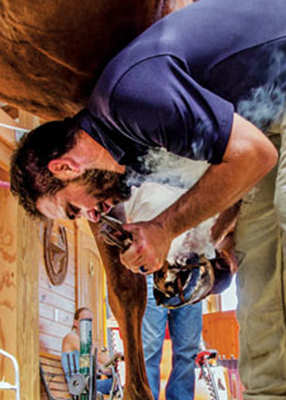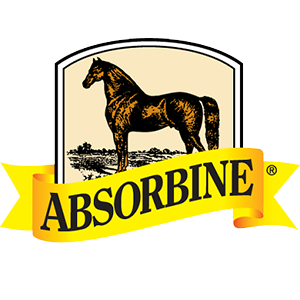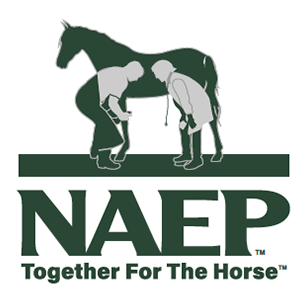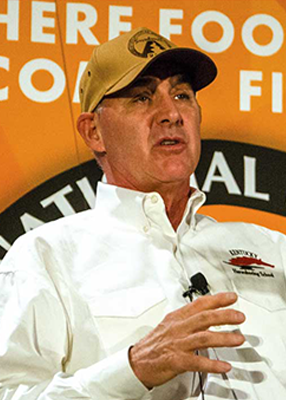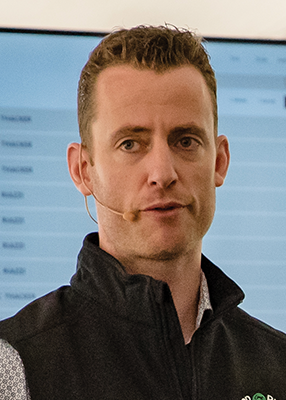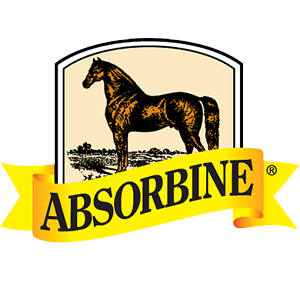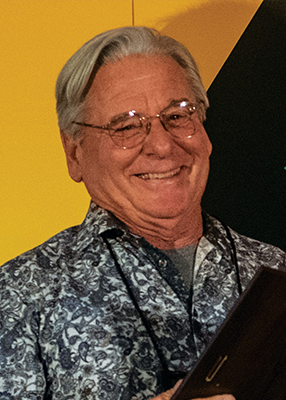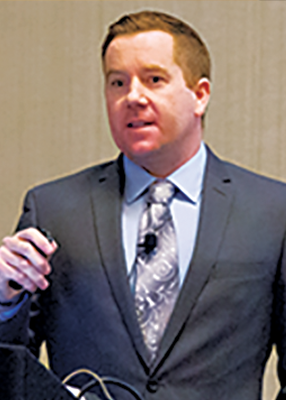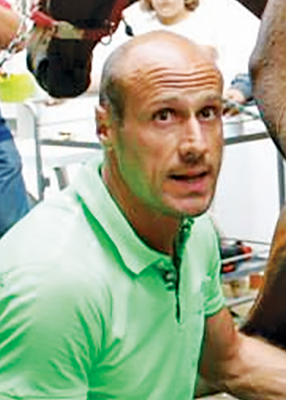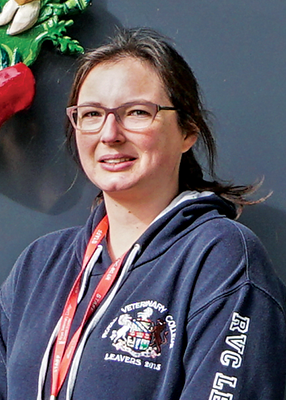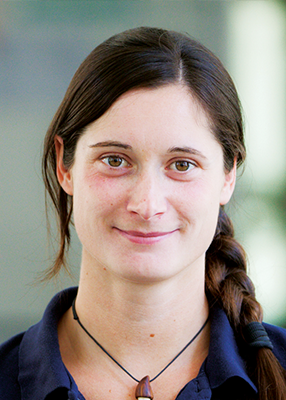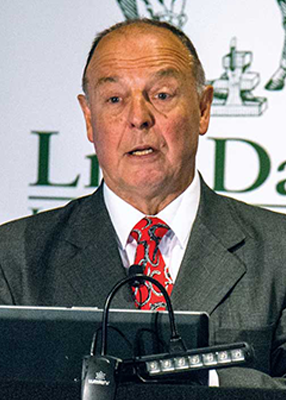Dissection of the Distal LimB
Mitch Taylor, CJF, AWCF, Kentucky Horseshoeing School, Richmond, Ky.
Watch Now
Learn more
In this dissection of the distal limb, Mitch Taylor will review the structure and function of the limb. He will also discuss some acute and chronic lamenesses that could occur as he progresses through the dissection. The limb is loaded in a press to show biomechanics at play.
Hide content
|
Dissection of the Equine Hoof Capsule
Mitch Taylor, CJF, AWCF, Kentucky Horseshoeing School, Richmond, Ky.
Watch Now
Learn more
In this session, Mitch Taylor dissects a cadaver limb hoof capsule from a young horse (a different horse from the distal limb dissection). Taylor will relate the internat structures to the rest of the distal limb.
Hide content
|
| |
Current Concepts on Biomechanical Basics of Therapeutic Farriery
Maarten Oosterlinck, DVM, PhD, Dipl. ECVSMR, Dipl. ECVS. EBVS, University of Ghent, Belgium
Watch Now
Learn more
In this presentation, University of Ghent researcher Maarten Oosterlinck will show how objective and quantitative tools to employ routinely in the assessment of equine locomotion and farriery techniques are gradually becoming available to the equine clinician and farrier. This presentation reviews the current biomechanical concepts that are important for evidence-based application of trimming and shoeing techniques in the treatment of lameness. The main issues that will be discussed are hoof balance, shock absorption, grip vs. sliding, the pressure distribution within the hoof, and hoof breakover. Also, possible effects on the hoof mechanism have to be considered. Ideally, these issues should be considered in the prevention of injury rather than in the treatment of established pathology.
Hide content
|
Using Farriery Principles: A Practical Look at the Equine Foot
Dr. Steve O'Grady, DVM, MRCVS, Keswick, Va.
Watch Now
Learn more
In this session, Dr. Steve O'Grady will discuss how sound farriery is based on principles. The horse’s foot is unique as it is a biological entity that follows the laws of physics. It is important to understand what a healthy foot before understanding unhealthy. In this session, O'Grady will discuss how farrier decisions affect equine anatomy and biomechanics.
Hide content
|
| |
Sponsor
Founded in 1892 by Wilbur Fenelon Young and his wife, Mary Ida, W. F. Young, Inc. has manufactured and distributed quality animal health care products for over 125 years. The company is recognized as a worldwide leader in innovative, specialized animal health care brands – including Absorbine® Veterinary Liniment, UltraShield® fly control, ShowSheen® grooming products, Leather Therapy® leather care, Hooflex® hoof care, and The Missing Link®supplements – that improve wellness and enhance the quality and enjoyment of life for people and their animals.
Learn more at: www.absorbine.com
|
| |
| |
Orientation of the Distal Phalanx as
Related to Pathologies (Part 1)
Mike Savoldi, Farrier and Researcher, Shandon, Calif.
Watch Now
Learn more
The shape of the hoof is a moment in time. This means that it is constantly changing. Recognizing these changes is the first step in developing a healthy foot. In this presentation, Hall of Fame farrier and researcher Mike Savoldi will discuss the importance of protecting bone structure, bone position, and bone movement within the hoof capsule to produce a healthy foot. Savoldi suggests traditional farrier science is in many ways hindering the farrier’s ability because it does not apply to the internal portions of the foot.
Hide content
|
Orientation of the Distal Phalanx as
Related to Pathologies (Part 2)
Mike Savoldi, Farrier and Researcher, Shandon, Calif.
Watch Now
Learn more
The position of the distal phalanx is critical when it comes to both hoof health and capsule shape. The shape of the hoof capsule will be determined and prescribed by the shape of the sole arch. The sole arch can be very deep (cupped foot) or it can be flat and shallow (flat foot). In part two of his presentation on the distal phalanx, Hall of Fame farrier and researcher Mike Savoldi will share strategies to learn how to work with the foot instead of dictating to it.
Hide content
|
| |
| |
Foal To Maturity: A Discussion Of
Comparative Anatomy (Part 1)
Paige Poss, APF, Tucson, Ariz.
Watch Now
Learn more
Farriers understand that the foal’s bones are still developing in the early months of the horse’s life. But what specifically are the differences between the immature and mature foot. In this presentation, Paige Poss of Tucson, Ariz., will survey the anatomy of these structures, first by discussing how the immature bone responds and adapts as it grows to maturity.
Hide content
|
Foal To Maturity: A Discussion Of
Comparative Anatomy (Part 2)
Stuart Muir, CJF, NZCEF, DipWCF, APF-I, resident farrier at Rood & Riddle Equine Hospital in Lexington, Ky.
Watch Now
Learn more
In the continuation of this lecture, Stuart Muir of Rood & Riddle Equine Hospital in Lexington, Ky., covers shoeing options in relation to assessment, growth plate education and a new grading scale they’ve adopted at the clinic. The talk goes into all common and not so common issues, including flexural deformities and treatment of club-footed foals. He’ll also survey several treatment options utilized by the footcare team at his clinic.
Hide content
|
| |
| |
Development Of A Biomechanical System
For Equine Analysis (Part 1)
Dominico Cellaro, Farrier, Turi, Italy
Watch Now
Learn more
Curious about forces on the foot in the dynamic state, Italian farrier Dominico Cellaro became inspired to create his own system for measurement. But it isn’t just a machine used as a novelty. Through his research, he’s uncovering interesting findings that help us understand how horseshoes affect the different gaits in relation to ground reaction forces.
Hide content
|
Development Of A Biomechanical System
For Equine Analysis (Part 2)
Dominico Cellaro, Farrier, Turi, Italy
Watch Now
Learn more
In his previous session, Italian farrier Domenico Cellaro shared how he developed his machine to measure the effect of ground reaction forces. In this talk, he’ll show how he was inspired to make this machine, how he built it and the future implications of his work with it.
Hide content
|
| |
Sponsor
With the NAEP being the first organization to include farriers in the definition of “equine practitioners”, the NAEP is actively encouraging the relationship between veterinarians and farriers as well as providing multiple educational opportunities to enhance their knowledge, skills and abilities.
We encourage farriers and veterinarians working together for the well-being of the horse through communication and continuing education.
Learn more at: www.theneaep.com
|
| |
Which Leg Is It: An Interactive Discussion Of Lameness.
Dr. Amy Barstow, PhD, Hertfordshire, England
Watch Now
Learn more
Lameness recognition is an important function of the farrier when looking at a horse in motion. Sometimes the indicators are not so obvious. In this presentation, Royal Veterinary College researcher Dr. Amy Barstow will discuss practices of lameness detection, and then lead an interactive discussion of a variety of cases. Attendees will be given the opportunity to vote on which leg is presenting the lameness by using a wireless voting tool. Barstow will read the results in real-time and reveal the actual problem limb and cause
Hide content
|
How Uneven Feet Affect Locomotion
Dr. Sarah Jane Hobbs, PhD, University of Central Lancashire, Preston, England
Watch Now
Learn more
Left-right symmetrical distal limb conformation can be an important prerequisite for a successful performance, and it is often believed that asymmetric or uneven feet are important enhancing factors for the development of lameness. On a population level, it has been demonstrated that uneven footed horses are retiring earlier from elite level competition, but the biomechanical consequences are not yet known. In this presentation, University of Central Lancashire biomechanics researcher Sarah Jane Hobbs will compare the functional locomotor asymmetries of horses with uneven feet to those with even feet. Her presentation will reveal fascinating results gained through hoof kinetics and limb kinematics.
Hide content
|
| |
| |
How To Affect The Equine
Fetlock Joint (Part 1)
Mitch Taylor, CJF, AWCF, Kentucky Horseshoeing School, Richmond, Ky.
Dr. Jenny Hagen, DVM, PhD, CF
Watch Now
Learn more
The fetlock joint is an incredible part of equine anatomy. Lameness that involves this joint is a common challenge for footcare professionals to address. In this presentation, Mitch Taylor, owner and operator of the Kentucky Horseshoeing School in Richmond, Ky., will survey the anatomy of the fetlock joint and surrounding structures. As Taylor performs the anatomical review, Dr. Jenny Hagen of the Equine Locomotor System and Hoof Orthopaedics at Leipzig University’s Institute of Veterinary Anatomy will present results from a study of the relationship between toe conformation and fetlock joint angle, as well as the effect of different wedges on internal structures associated with the fetlock joint.
Hide content
|
How To Affect The Equine
Fetlock Joint (Part 2)
Mitch Taylor, CJF, AWCF, Kentucky Horseshoeing School, Richmond, Ky.
Dr. Jenny Hagen, DVM, PhD, CF
Watch Now
Learn more
Mitch Taylor continues with the dissection, while Dr. Jenny Hagen will relate this complex anatomy to the physiological function of the performance horse. Their combined presentation will further reveal how orthopedic device selection affects the function of the fetlock joint.
Hide content
|
| |
| |
Hoof Development: From Fetus to Maturity
Dr. Simon Curtis (FWCF), Farrier and Researcher, Newmarket, England
Watch Now
Learn more
Newmarket, England, farrier Simon Curtis has presented remarkable work on the Thoroughbred over the years. In this Summit lecture, he will present how the equine hoof develops, beginning from fetus through though its maturity. As the foot matures, Curtis will share important insight on hoof loading and growth. He’ll use microscopic studies and pressure mat data to deliver essential points to this lecture. This presentation will help bridge the understanding of Curtis’s other talks at the Summit.
Hide content
|
An Anatomical Review Of The Features And Effects Of Different Foot Types
Mitch Taylor, CJF, AWCF, Kentucky Horseshoeing School, Richmond, Ky
Watch Now
Learn more
Different foot types affect the inside of the hoof and distal limb? For this presentation, Mitch Taylor, owner and operator of the Kentucky Horseshoeing School in Richmond, Ky., will bring a variety of equine cadaver feet that represent a wide spectrum of foot types Through dissecting each foot and limb at different stages, he’ll first establish a foundation for the parameters of this review.
Hide content
|



